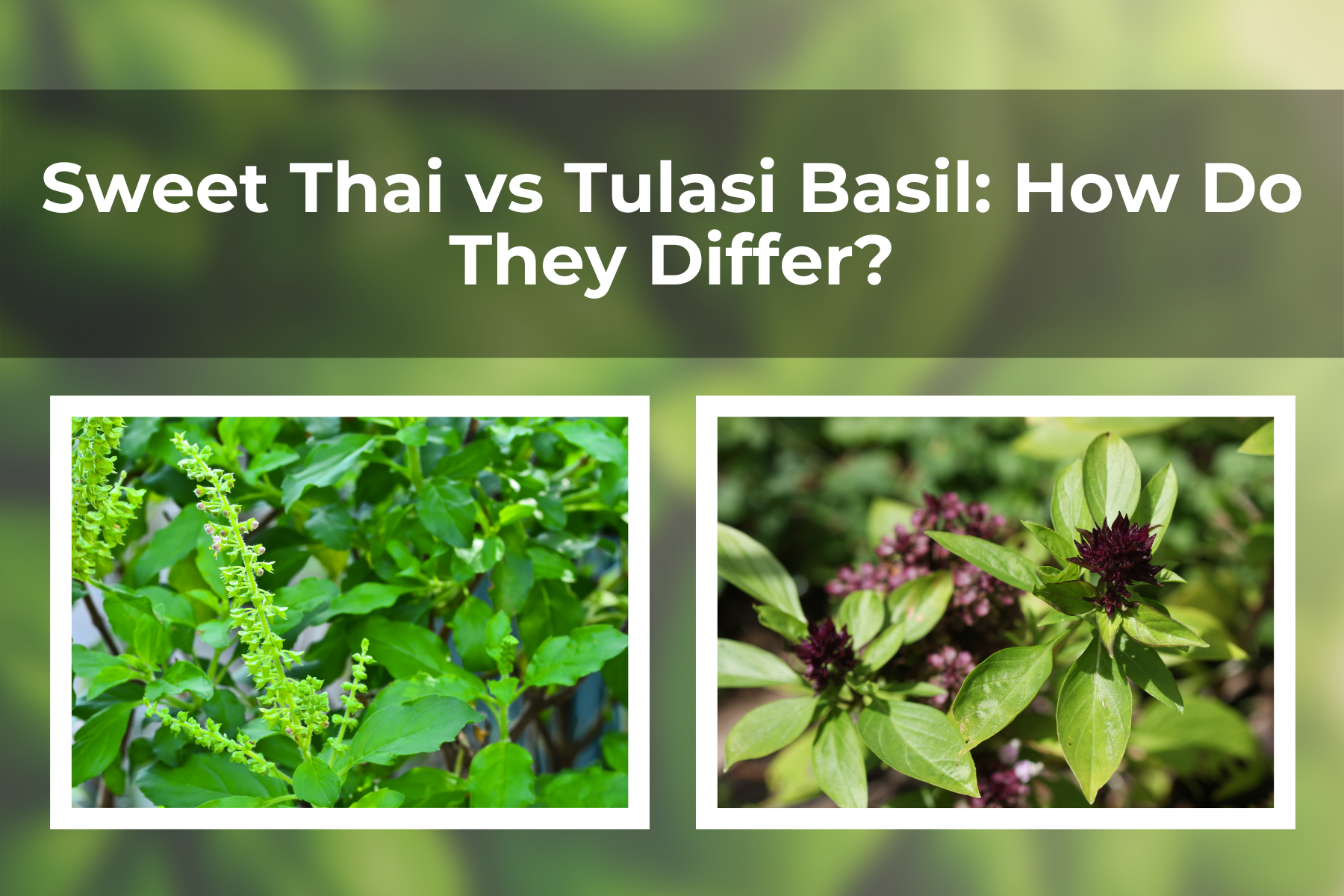Last Updated on April 9, 2024 by Real Men Sow
Exactly how do Sweet Thai vs Tulasi basil differ? Well, we know both herbs are used for cooking and medicinal purposes. They also both belong to one plant family. Before explaining how to grow each one at home, this guide will discuss their similarities and differences.
Sweet Thai Basil
The cultivation of Sweet Thai is common in Southeast Asia due to its ornamental characteristics and its ability to flavour dishes. It is a member of the mint family and has a lovely aroma; the popular name for this plant is Thai basil. This plant has the potential to reach a height of one and a half feet and blooms in various shades of blue, purple, and pink.
Description
Sweet Thai or Thai basil can grow to three feet (90 cm) in its native habitat. It is unique because it has purple stems, narrow leaves, and a serrated edge. The leaves are usually green with purple accents around their veins.
Thai basil can produce clusters of purple flowers if it is allowed to flower. They look similar to mint blossoms and are as fragrant as the leaves. Thai basil is usually kept small as a shrub. The stems and flower buds should be regularly trimmed to preserve flavor and encourage bushiness.
Sweet Thai Basil: Uses
Thai basil can be used in many different dishes and is fun. It’s more flexible than other basil varieties and can withstand higher temperatures without losing its texture or aroma. It can be used fresh or cooked. It’s best to use it in Thai-style dishes to enhance its authentic flavor.
Tulasi or Thai Holy Basil
Holy basil (Tulsi) is a type of basil that is native to India. However, It’s more common in Thai cuisine. It is so well-known in Thailand that it was given the Thai holy basil name. It can be challenging to distinguish it from Thai basil. They are both different herbs with a unique aromas.
Description
The holy basil perennial shrub can grow to between 30 and 60 cm in height (30-70 cm). The leaves are usually green and small and have noticeable serrations at the edges. Some varieties, like the Krishna Tulsi, have purple leaves. They are more common in India and Nepal.
Holy Basil: Uses
The holy basil variety, like Thai basil, is exceptionally aromatic. It has a sweet taste, a clove aroma, and mild hints of lemon, black pepper, and peppermint. This delicate herb is best enjoyed fresh, right after you have finished cooking. It can also be dried and used to make tea.
Sweet Thai vs Tulasi Basil (in the kitchen)
When it comes to cooking, it’s best to use Thai basil and holy basil fresh. However, if you cannot use them immediately, you’ll have to know the best way to preserve them. You will need to dry holy basil and place it in paper bags. Thai basil leaves can be washed and dried with a paper towel. Then, store them in the freezer. Note that holy and Thai basil are not good at refrigerating, so avoid it if you can.
Let us check what Sweet Thai vs Tulasi Basil varieties difference in cooking:
Tulasi or Holy Basil: In the Kitchen
A more petite, delicate herb that is mainly used as a medicine. It makes a great tea with mild minty flavors and clove aromas.
Fresh leaves can also be used in cooking, such as in stir-fries and soups, Asian-style noodles, and curries. You should add them at the end of the cooking process, as heat and prolonged cooking times can destroy their flavor and texture.
Sweet Thai Basil: In the Kitchen
The best option if you are looking for a culinary herb. Thai basil leaves retain their aroma and texture better after cooking because they are thicker. It is an excellent addition to Thai, Vietnamese, and Cambodian dishes. If you don’t mind its licorice flavor, you can make pesto with it.
Italian basil vs. Asian basil varieties
Great basil (Ocimum Basilicum) is the most common variety of basil in Western cuisine. Its sweet flavor matches perfectly with tomatoes. However, it can also be used in pesto and other sauces like lemonade.
What’s the difference between Italian basil and Asian basil varieties like Thai or holy basil? Taste is the most critical factor.
Italian Basil: Description
Mildly sweet with a mild peppery aroma. There is a slight mint and anise note. The Italian variety is large and round, with green leaves. It looks very similar to spinach. The leaf’s edges are smooth and slightly concave.
Final Remark
Both Sweet Thai and Tulasi Basil offer different benefits, making them great additions to your garden. It is simple to grow them at home, especially if this guide is followed! Let’s review the basics:
- Sweet Thai and Tulasi Basil are both parts of the same plant family, but they are two different species.
- Their appearance usually distinguishes them. Sweet Thai basil has purple stems and tiny pointy leaves. Tulasi Holy basil is larger and more green with shorter, rounder leaves.
- They also smell and taste differently. Sweet Thai basil is bursting with anise and licorice notes; Tulasi holy basil has clove, black pepper, and lemon.
- Sweet Thai basil is best for cooking, but Tulasi holy basil is used more often for medicinal purposes. It makes great tea and is excellent for aromatherapy.
- Both species can be quickly grown in containers using seeds or cuttings.

